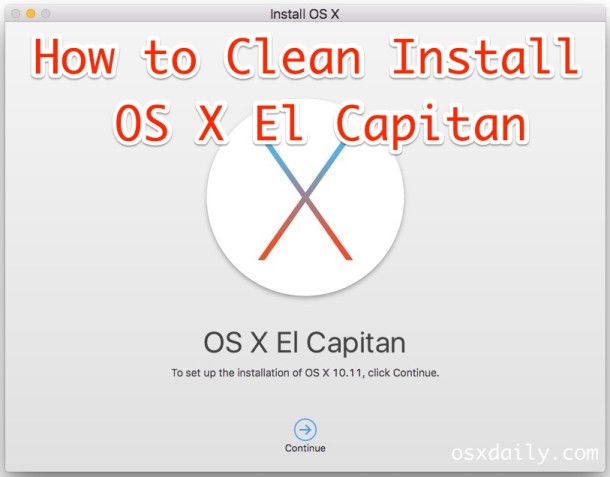Installing El Capiton on an old Mac Book Pro today, I received the error:
Download El Capitan Installer
In this video I cover how to format internal and external hard drives, solid state drives, thumb drives, and SD cards with Disk Utility in Mac OS X 10.11 'El. 'OSX update cannot be installed on this disk does not meet requirements' I have gone to disk utility and checked and repaired the permissions and even ran disk verify all is OK. The drive has one partition which I named the same as the last HDD 'Macintosh HD' it has 1.7 TB available space showing with the root directory '/' at the top of the.
MacOS – 2012 MacBook Pro OS X El Capitan wont boot into windows 8.1 after a HD partition change bootcamp macos partition I had windows 8.1 installed with bootcamp and it was running fine but I ran out of space on the partition I originally created. Indented (usually, Macintosh HD)entry from the side list. Click on the First Aid button in the toolbar. Wait until the operation. Completes, then quit Disk Utility and returnto the Utility Menu. Download and Install OS X El Capitan 10.11.6 Combo Update. Reinstall OS X: Reboot from the Recovery HD.

OS X could not be installed on your computer
No packages were eligible for install. Contact the software manufacturer for assistance.
Quit the installer to restart your computer and try again.
I checked Apple’s support Matrix (it is a very old macbook pro) at https://support.apple.com/kb/SP728?locale=en_GB and it was listed as supported.
Os X El Capitan Cannot Be Installed On Macintosh Hd Computer
After lots of Googling and investigation, I discovered that the date and time were not set to current, the macbook thought it was year 2000.
You can easily reset the time and date by following the steps below:
- Click Utilities on the menu bar
- Select Terminal
- Type date
- Confirm the date is wrong
- Type date 062112422016 (example: June 21st 12:42 2016)
- Exit terminal
- Click Restart
Once the Date and time are configured you will be able to install OS X.
Easy fix, for a ridiculous error!
Start up from macOS Recovery
Determine whether you're using a Mac with Apple silicon, then follow the appropriate steps:

Apple silicon
Os X El Capitan Cannot Be Installed On Macintosh Hd Free
Turn on your Mac and continue to press and hold the power button until you see the startup options window. Click the gear icon labeled Options, then click Continue.
Intel processor
Make sure that your Mac has a connection to the internet. Then turn on your Mac and immediately press and hold Command (⌘)-R until you see an Apple logo or other image.
If you're asked to select a user you know the password for, select the user, click Next, then enter their administrator password.
Reinstall macOS
Select Reinstall macOS from the utilities window in macOS Recovery, then click Continue and follow the onscreen instructions.
Follow these guidelines during installation:
- If the installer asks to unlock your disk, enter the password you use to log in to your Mac.
- If the installer doesn't see your disk, or it says that it can't install on your computer or volume, you might need to erase your disk first.
- If the installer offers you the choice between installing on Macintosh HD or Macintosh HD - Data, choose Macintosh HD.
- Allow installation to complete without putting your Mac to sleep or closing its lid. Your Mac might restart and show a progress bar several times, and the screen might be empty for minutes at a time.
After installation is complete, your Mac might restart to a setup assistant. If you're selling, trading in, or giving away your Mac, press Command-Q to quit the assistant without completing setup. Then click Shut Down. When the new owner starts up the Mac, they can use their own information to complete setup.
Other macOS installation options
When you install macOS from Recovery, you get the current version of the most recently installed macOS, with some exceptions:
- On an Intel-based Mac: If you use Shift-Option-Command-R during startup, you're offered the macOS that came with your Mac, or the closest version still available. If you use Option-Command-R during startup, in most cases you're offered the latest macOS that is compatible with your Mac. Otherwise you're offered the macOS that came with your Mac, or the closest version still available.
- If the Mac logic board was just replaced, you may be offered only the latest macOS that is compatible with your Mac. If you just erased your entire startup disk, you may be offered only the macOS that came with your Mac, or the closest version still available.
You can also use these methods to install macOS, if the macOS is compatible with your Mac:
- Use the App Store to download and install the latest macOS.
- Use the App Store or a web browser to download and install an earlier macOS.
- Use a USB flash drive or other secondary volume to create a bootable installer.